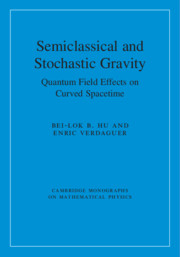Book contents
- Frontmatter
- Dedication
- Contents
- Preface
- 1 Overview: Main Themes. Key Issues. Reader’s Guide
- Part I Effective Action and Regularization, Stress Tensor and Fluctuations
- Part II Infrared Behavior, 2PI, I/N, Backreaction and Semiclassical Gravity
- Part III Stochastic Gravity
- 9 Metric Correlations at One-Loop: In-In and Large N
- 10 The Einstein–Langevin Equation
- 11 Metric Fluctuations in Minkowski Spacetime
- Part IV Cosmological and Black Hole Backreaction with Fluctuations
- Part V Quantum Curvature Fluctuations in de Sitter Spacetime
- References
- Index
10 - The Einstein–Langevin Equation
from Part III - Stochastic Gravity
Published online by Cambridge University Press: 20 January 2020
- Frontmatter
- Dedication
- Contents
- Preface
- 1 Overview: Main Themes. Key Issues. Reader’s Guide
- Part I Effective Action and Regularization, Stress Tensor and Fluctuations
- Part II Infrared Behavior, 2PI, I/N, Backreaction and Semiclassical Gravity
- Part III Stochastic Gravity
- 9 Metric Correlations at One-Loop: In-In and Large N
- 10 The Einstein–Langevin Equation
- 11 Metric Fluctuations in Minkowski Spacetime
- Part IV Cosmological and Black Hole Backreaction with Fluctuations
- Part V Quantum Curvature Fluctuations in de Sitter Spacetime
- References
- Index
Summary
Whereas semiclassical gravity is based on the semiclassical Einstein equation with sources given by the expectation value of the stress-energy tensor, stochastic gravity is based on the Einstein–Langevin equation, which in addition has sources due to the noise kernel. The noise kernel is a bitensor which describes the quantum stress-energy tensor fluctuations of the matter fields. In this chapter we describe the fundamentals of this theory using an axiomatic and a functional approach. In the axiomatic approach, the equation is introduced as an extension of semiclassical gravity motivated by the search for self-consistent equations describing the backreaction of the stress-energy fluctuations on the gravitational field. We then discuss the equivalence between the stochastic correlation functions for the metric perturbations and the quantum correlation functions in the 1/N expansion, and illustrate the equivalence with a simple model. Based on the stochastic formulation, a criterion for the validity of semiclassical gravity is proposed. Alternatively, stochastic gravity is formulated using the Feynman–Vernon influence functional based on the open quantum system paradigm, in which the system of interest (the gravitational field) interacts with an environment (the matter fields).
Keywords
- Type
- Chapter
- Information
- Semiclassical and Stochastic GravityQuantum Field Effects on Curved Spacetime, pp. 337 - 363Publisher: Cambridge University PressPrint publication year: 2020

